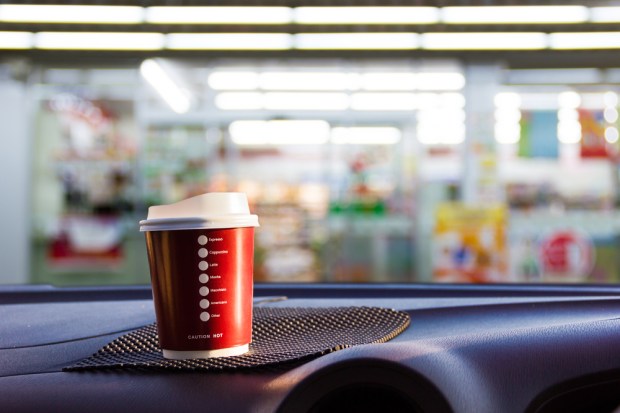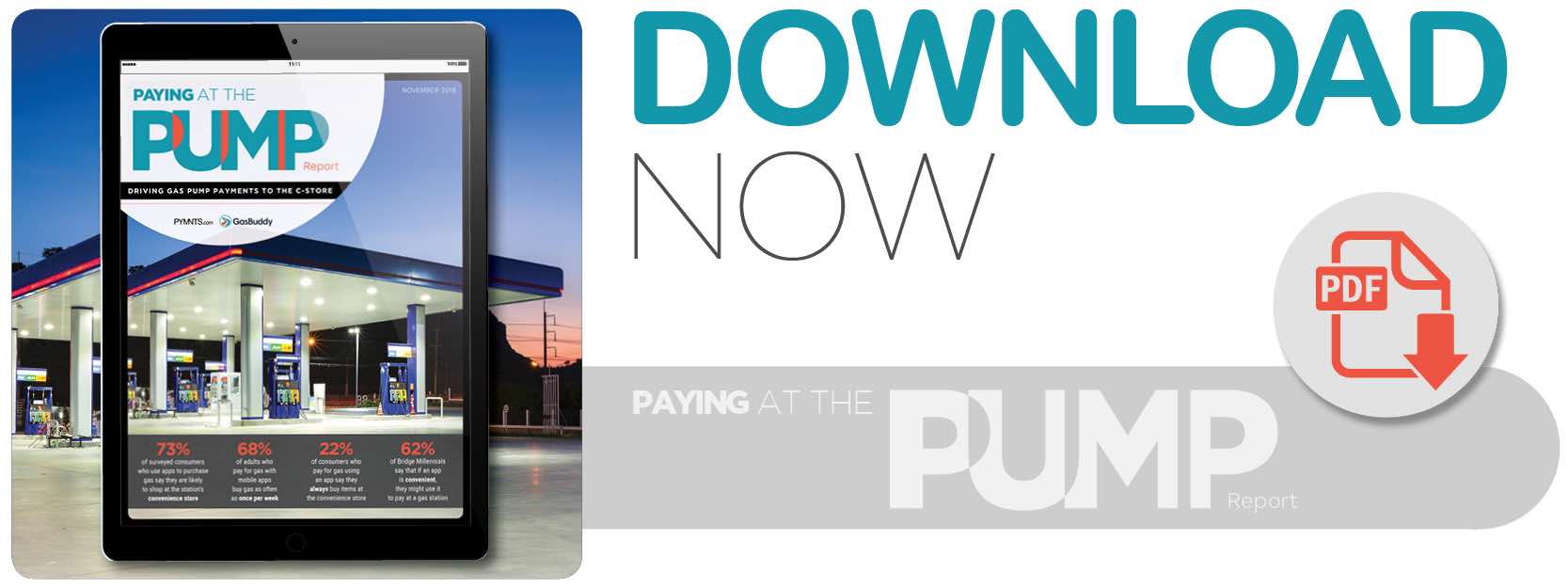C-Stores Seek Their Own ‘Starbucks Effect’ With Mobile Apps

Some 48.5 million U.S. travelers are expected to hit the road for Thanksgiving, and roughly half will use apps to find gas deals. According to the new PYMNTS Paying At The Pump Report, once these mobile-savvy consumers fuel up, they’re likely to shop at the gas station’s convenience store. Find over 350 data points, outlining the $22 billion opportunity to drive gas patrons into c-stores, inside the report.
Gas station owners eager to offer mobile app technology that drives consumers from the pump into the convenience store (c-store) might benefit from thinking more like coffee merchants.
According to the latest figures from the National Association of Convenience Stores (NACS), 80 percent of gasoline in the U.S. is sold by convenience stores, meaning merchants have a significant opportunity to lure consumers from the pump to convenience store aisles, where they can use their gas apps to buy sodas, snacks, cigarettes or other products.
Merchants seeking to make mobile apps more integral to convenience store shopping could get a shot of inspiration from the strategies used by coffee chains like Starbucks and Dunkin’ Donuts. Those businesses have been highly successful at offering a mobile shopping experience that lets customers pre-order items or pay for them in-store.
PYMNTS recently spoke with Amy Murphy-St Laurent, loyalty manager for New England-based gas station and convenience store chain Alltown, and Jeff Lenard, vice president of strategic industry initiatives for NACS, about how convenience stores can look outside their market for mobile app innovation and inspiration.
Brewing Mobile App Inspiration For Convenience Stores
Coffee giants like Starbucks and Dunkin’ Donuts have mastered the mobile app experience, Murphy-St Laurent noted. She added that gas station and c-store operators could learn a great deal about their own mobile strategies from the coffee chains, despite the fact that they’re in different markets.
“We’re always very interested in companies that have really driven, very strong app usage,” she said. “It’s certainly not necessarily convenience store-based, but the idea [is to create] an app that becomes a seamless part of the way the customer transacts with [a business] every single day.”
For its part, Alltown is already tailoring its mobile app to how customers engage with its brand. Earlier this year, the company launched a mobile app on iOS and Android devices for users to buy gas at the pump and items in the convenience store. The app also includes a points-based loyalty program that allows users to redeem points for discounts on gas and other products.
In addition to convenience stores and gas stations, several of Alltown’s 74 locations across New England include services such as car washes, deli counters, full kitchens and propane tank refills, said Murphy-St Laurent. These different services provide loyalty members with multiple opportunities to use their points.
Though Alltown’s app is in its early stages, making it hard to establish a definitive pattern of usage, early adopters are using it to make payments both at the pump and in the convenience store. Murphy-St Laurent added that the company’s mobile app strategy will likely continue to incorporate lessons from Starbucks and Dunkin’ Donuts.
“The way they have ingrained the app into day-to-day business, having mobile payments tied to it and having the ability to pre-order and earn rewards — they are definitely great examples to keep an eye on,” she said.
Getting To Know The Consumer
Alltown sees the growing usage of its app as an opportunity to develop a stronger relationship with its customers. To accomplish this, Alltown will review the data its app generates to determine how customers, who use it to buy gas, end up entering the convenience store, allowing the company to develop a more accurate customer profile. According to Murphy-St Laurent, this information will help Alltown tailor its app to users’ previous activities.
“The long-term goal of the program is to use that information and use that data to drive a far more personal relationship with the customer, and deliver more personalized and targeted rewards based on the type of shopper that they are,” she said.
An Inconvenient Truth For C-Stores
Lenard agreed that mobile apps offer gas stations and c-stores an opportunity to build upon their relationships with customers, and that coffee chains’ models serve as inspirations for the market.
“Starbucks has been very effective with the idea that everything is convenient,” Lenard said. “You have your app, you order, you pick a location, you go there, the transaction’s done and you’re on your way. That’s convenience.”
Mobile apps, he said, allow NACS’ 122,000 nationwide c-store members to remain competitive. However, while c-stores can learn from what big brands are accomplishing with their mobile apps, Lenard said larger businesses are also taking ideas from the c-store model.
“What convenience stores are looking at right now is that their competition is everyone,” Lenard said.
Over the years, he explained, several businesses have emulated the c-store model, which allows customers to enter, buy items and leave quickly. Quick-service restaurants (QSRs) like McDonald’s offer kiosks, where customers can quickly order meals. Even supermarkets have incorporated c-store strategies by moving the most popular items toward the front of the store so customers can find them quickly.
“Everyone is selling convenience,” he said.
Murphy-St Laurent said Alltown will continue to closely watch how non-gas and c-store merchants offer their own brands of convenience.
“Any good marketer is always looking at what is out there in the marketplace, especially in retail, looking beyond your specific lane,” she said. “As we grow our own brand, we’ll look at new and innovative approaches that we can be first to the market with.”
In a crowded mobile app market, with many businesses trying to expand their reach, c-stores have plenty of ideas and inspirations to brew over.
About The Paying At The Pump Report
For the Paying At The Pump Report: Driving Gas Pump Payments To The C-Store, a GasBuddy collaboration, PYMNTS surveyed over 10,000 consumers about how they use mobile apps for their gas purchases. The report includes over 350 data points that outline the mobile app features and functions that consumers value most at the gas pump, and the features that encourage them to visit stations’ convenience stores.

